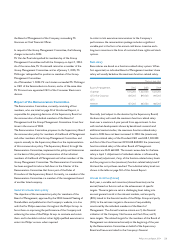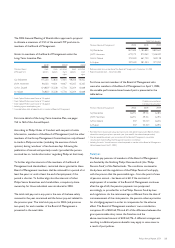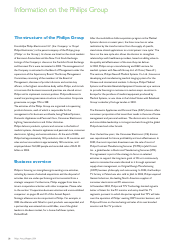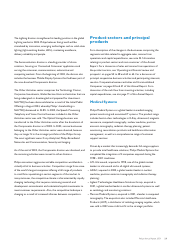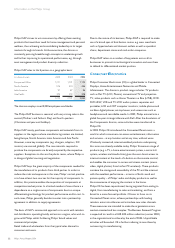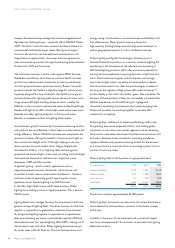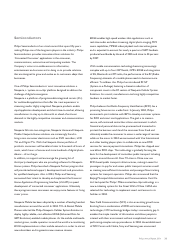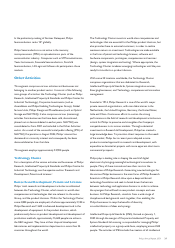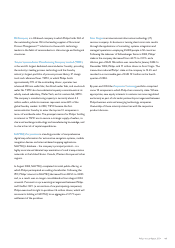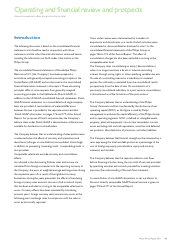Philips 2004 Annual Report Download - page 34
Download and view the complete annual report
Please find page 34 of the 2004 Philips annual report below. You can navigate through the pages in the report by either clicking on the pages listed below, or by using the keyword search tool below to find specific information within the annual report.
Several actions were taken in 2004 to further implement its
strategy. An agreement was signed with IBM to transform and
manage CE’s service activities in North America. Also in 2004
Philips acquired Gemini Industries, the leading North American
supplier of consumer electronics and PC accessories. This will
allow growth of higher-margin peripherals and accessories
business activities on a global scale. During 2004, the front
projector and micro-displays businesses were exited. In
November 2004, the Polish television assembly plant was sold to
global electronics manufacturer Jabil Circuit, Inc. In December
2004, Philips and TPV Technology Limited signed a Letter of Intent
for the PC monitor and entry level Flat TV segments, pursuant to
which the parties agreed that TPV will take over the operation of
Philips’ existing Original Equipment Manufacturing (OEM) monitor
business, and Philips will focus on the marketing and sales of its
own branded monitor and Flat TV products.
Philips CE sales to third parties on a geographic basis:
(in millions of euros) 2002 2003 2004
Europe and Africa 5,275 4,957 5,194
North America 2,390 2,131 2,011
Latin America 648 514 731
Asia Pacific 1,542 1,586 1,983
9,855 9,188 9,919
The division employs approximately 17,000 people.
The CE business experiences seasonality, with higher sales in the
fourth quarter resulting from the holiday sales.
Philips CE mainly purchases components from suppliers in the
regions where assembly centers are located. The raw materials
required to produce the components are directly acquired by the
respective suppliers, except for key components like cathode-ray
tubes (CRT), LCD panels and plastics. In order not to rely on one
supplier only, it is normal practice for Philips to have a second
source for the majority of components. In addition, this practice
enables the acquisition of components at competitive market
prices. In a limited number of cases there is a dependence on a
single source of components due to a unique differentiating
technology for product performance and/or cost. In such cases,
Philips generally decides to enter into a partnership agreement in
addition to supply agreements. In a number of cases, these
partnerships are made with other Philips businesses (e.g. Philips
Semiconductors and Philips Optical Storage) and (joint) ventures
(like LG.Philips LCD and LG.Philips Displays).
In general, commodity pricing and availability are subject to the
general market cycles, mostly linked to the macro-economy.
The basis of CE’s commercial approach is to work with retailers,
distributors and integrators operating locally and across a region,
who wish to grow with Philips whilst furthering Philips’ brand
values and commercial principles. For Philips’ corporate Business
to Business, or B2B, and OEM customers, the approach is more
global.
Retail trade (including PC retailers) and CE wholesalers form the
typical sales channels to consumers (Business to Consumer, or
B2C). Due to the nature of the CE business, Philips is required to
make use of a broad span of distribution routes, e.g. mass
merchants such as hypermarkets and discount outlets as well as
specialist chains, PC retailers, department stores and mail-order
companies. B2B channels are characterized by sales to PC/IT
distributors, corporate or incentive sales, and sales to system
houses/integrators, telecommunications operators and
broadcasters (where applicable).
Philips’ significant portfolio of intellectual property allows CE to
enter into cross-licenses with other major companies with
similarly large intellectual property portfolios.
Lighting
Philips has been engaged in the lighting business since 1891 and is a
leader in the world market for lighting products (in terms of sales,
profitability and product range) with recognized expertise in the
development and manufacture of lighting products. A wide variety
of applications is served by a full range of incandescent and halogen
lamps, compact and normal fluorescent lamps, automotive lamps,
high-intensity gas-discharge and special lamps, LED (light-emitting
diode)-based lighting, QL induction lamps, fixtures, ballasts and
lighting electronics. Lighting products are manufactured in some
70 manufacturing facilities worldwide. Philips’ worldwide presence
in the lighting market has given it an important international
position in lighting projects, both in design and full-scale project
business. These activities require sophisticated expertise which
helps Philips to maintain its leading position (in terms of sales and
product range) in the professional lighting market.
Philips Lighting worldwide consists of four businesses: Lamps,
Luminaires, Automotive, Special Lighting & UHP, and Lighting
Electronics.
Within Lamps, the largest business, the main growth areas are the
thin 16 mm T5 fluorescent lamps, halogen lamps,
33Philips Annual Report 2004


